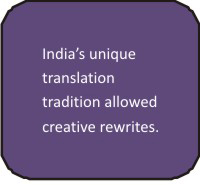Conclusion
What is given above is not a definitive or comprehensive list of all the adaptations or re tellings of both epics. It was just a random sampling that was meant to give an idea of the breadth and depth of the field. However, the multitude of retellings or translations does raise the question that is faced by every translator – how sacrosanct is the basic text and how faithful do you have to be in translation? It is clear that the concern with fidelity and equivalence was not an overriding one. Shanta Ramakrishna says: “Indian translators have not traditionally been preoccupied with the question of fidelity; adaptations were and still continue to be quite common. Whereas in the past such adaptations were well received and welcomed by readers as important contributions to the development of language and literature, the modern-day translator and his bilingual critic often attach undue importance to the question of fidelity” (87). It is this Indian concept of a fluid source text (which is very similar to poststructuralist concepts) that has been lost in translation today. The various translations are somewhat similar to the oral nature of epics, whereby matter was added, dropped or transformed to suit the context in which it was used; this resulted not in a ‘faithful’ translation, but a palimpsest. Perhaps this attitude to translation would rid translators of the gnawing worry of strategies of translation that would help them attain equivalence. tellings of both epics. It was just a random sampling that was meant to give an idea of the breadth and depth of the field. However, the multitude of retellings or translations does raise the question that is faced by every translator – how sacrosanct is the basic text and how faithful do you have to be in translation? It is clear that the concern with fidelity and equivalence was not an overriding one. Shanta Ramakrishna says: “Indian translators have not traditionally been preoccupied with the question of fidelity; adaptations were and still continue to be quite common. Whereas in the past such adaptations were well received and welcomed by readers as important contributions to the development of language and literature, the modern-day translator and his bilingual critic often attach undue importance to the question of fidelity” (87). It is this Indian concept of a fluid source text (which is very similar to poststructuralist concepts) that has been lost in translation today. The various translations are somewhat similar to the oral nature of epics, whereby matter was added, dropped or transformed to suit the context in which it was used; this resulted not in a ‘faithful’ translation, but a palimpsest. Perhaps this attitude to translation would rid translators of the gnawing worry of strategies of translation that would help them attain equivalence.
Assignments
- How is the translation tradition of Ramayana different from that of the Mahabharata?
- Try to ‘translate’ any character of the Ramayana from your point of view. Analyse the result and evaluate how much of your own personal ideology has influenced the retelling.
References
Dash, Debendra K. and Dipti R. Pattanaik. “Translation and Social Praxis in Ancient and Medieval India (with special reference to Orissa)”. In Translation: Reflections, Refractions, Transformations. Eds. Paul St-Pierre and Prafulla C. Kar. Delhi: Pencraft International, 2005: 131-150.
Paley, Nina. Sita Sings the Blues. www.sitasingstheblues.com
Ramakrishna, Shanta. “Cultural Transmission through Translation: An Indian Perspective”, Changing the Terms: Translating in the Postcolonial Era. Eds. Sherry Simon and Paul St-Pierre. Hyderabad: Orient Longman, 2002: 87 – 100
Richman, Paula, editor. Many Ramayanas: The Diversity of a Narrative Tradition in South Asia. Berkeley: University of California Press, c 1991. http://ark.cdlib.org/ark:/13030/ft3j49n8h7/ |
|